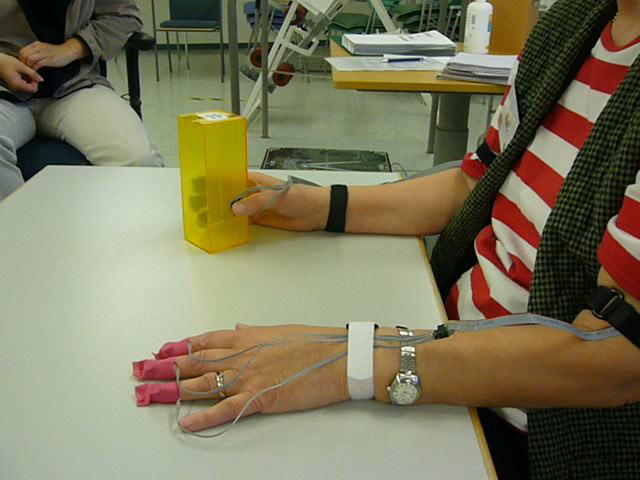new web: http://bdml.stanford.edu/pmwiki
TWiki > Haptics Web>StanfordHaptics > TampereStanfordPortableHapticsProject > TauchiRehabilitationProject > PortableLowCostHapticForMultipleSclerosis>ExperimentProcedure (06 Dec 2007, LiJiang? )
Haptics Web>StanfordHaptics > TampereStanfordPortableHapticsProject > TauchiRehabilitationProject > PortableLowCostHapticForMultipleSclerosis>ExperimentProcedure (06 Dec 2007, LiJiang? )
-- LiJiang? - 06 Dec 2007

The task in the experiments is inspired by the everyday
task of lifting a glass of water. The proxy for the
glass is a hollow plastic parallelepiped, 5.7mm ◊ 5.7mm ◊ 15.5mm, weighing 73 grams. We asked subjects to grasp
this object and raise it several centimeters from a table top,
hold it for several seconds and then replace it. We informed
the subjects that they should try to hold the object steadily
and to balance the forces among their fingers to prevent
it from tipping. When subjects reported that they felt the
forces were balanced, we recorded the forces for 5 seconds
and then asked them to replace the object.
Three haptic feedback modes were selected: no haptic
feedback (NHF), amplitude based feedback (ABF),
and event-cue feedback (ECF). The characteristics of each
feedback mode are discussed in the next subsection. A
within subject test was conducted. 24 multiple sclerosis patients
were recruited as subjects at the Masku Neurological
Rehabilitation Center in Finland. Eight of those subjects
are males, sixteen are females. The range of ages is from
33 to 64 with a mean of 56.4. The recruited subjects all
have reduced sensation in one hand and good sensation in
the other hand. They were all able to fully understand the
human consent form and able to follow the simple instructions
required to complete the sessions.
Since three different feedback modes were provided,
there are six possible orderings of the three feedback modes
for each subject (NHF-ABF-ECF, NHF-ECF-ABF,etc...).
All 24 subjects completed the designed task under each of
the three feedback modes with three trials for each mode,
for a total of nine trials in one of six possible orderings. For
example, a subject might do three trials with ABF, followed
by three with NHF and three with ECF.
Before the tests, subjects were given time to get familiar
with conducting the task under the three different feedback
modes. The pretest practice sessions took from 30 to
60 minutes depending on the individual. Also, whenever
subjects switched modes, they were given several practice
trials with the new mode.
Experiment Procedure
For patients who have one limb that is more impaired than the other, there is an opportunity to provide haptic feedback to the less affected limb to improve performance in handling objects. For the experiments in this paper, force sensors are attached to the index, middle and ring fingers of a subjectís more impaired hand and vibrotactile stimulators are attached to the back of the fingernail on the corresponding fingers of the less impaired hand.
Ideas, requests, problems regarding TWiki? Send feedback